


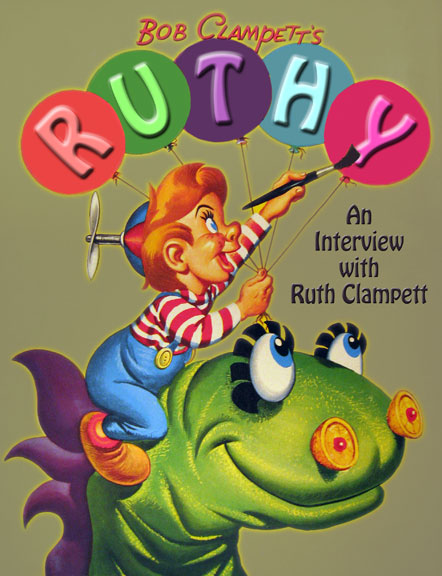
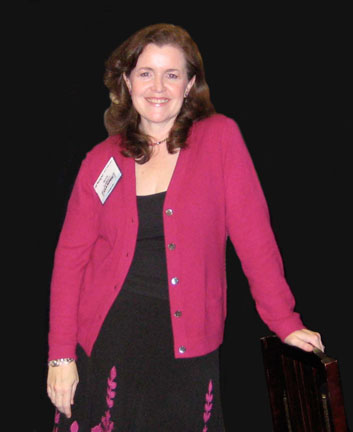
Ruth Clampett owns and operates Clampett Studio Collections in Burbank, CA. It’s an art animation studio that produces and sells limited edition prints and cels of the most famous characters in animation history — Bugs Bunny, Superman, Daffy Duck, and many more. It all began with some cartoons created by her father, the legendary animator Bob Clampett, who was one of the key animation directors during the golden years of animation at Warner Bros. He also created Beany and Cecil in the 1950s and 1960s, which began as a live puppet show called “Time for Beany,” and later became an animated show. During its popularity Beany and Cecil were two of the most recognizable and beloved characters on television. Children and adults alike were captivated by their weekly adventures filled with humor, wit and an undaunting enthusiasm.
This enthusiasm carried over into the life of its creator, as well as his family. I sat down recently with Ruth Clampett to discuss her life and career as well as her father's. Ruth possesses the same passion for life that her father did.
THE INTERVIEW (transcribed by Paul Uhlenkott)
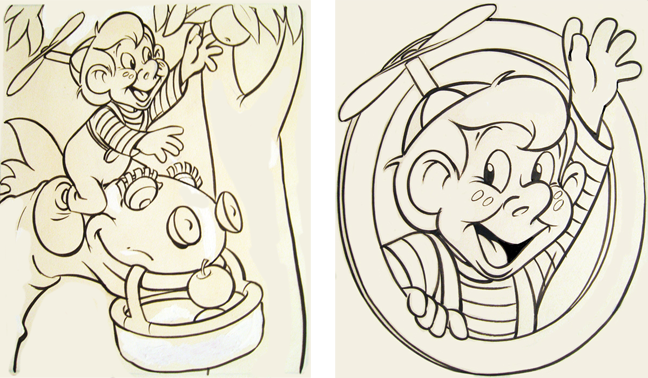
Early drawings of Beany and Cecil from 1950s.
The Writing Disorder: Let’s start with a little about your background. Where did you go to school?
Ruth Clampett: I grew up in West Hollywood and went to Fairfax High school which is on Melrose Ave. This was before it became such a hip area. After graduating from Fairfax, I wanted to study graphic design. At first I went to the University of Arizona, because I wanted to have a college experience away from home. But after a few years, I thought that if I wanted to live in Los Angeles, I should probably attend one of the better art schools there. I took a design class at Otis Parsons, and I took a photography class at Art Center, and that’s when I fell in love with photography. So I ended up going to Art Center College of Design in Pasadena and got my degree in photography. To this day, I still love photography.
It’s funny, but back when I attended Art Center, Pasadena was just a sleepy town. We never had any place to go after school. Then a couple of years after I graduated, Pasadena was revitalized, and now it’s a great place — and very dynamic. My timing seems to be a bit off with the hip places.
It was during my sixth term at Art Center that my dad passed away. It was a very sudden thing — a heart attack while he and my Mom were traveling around the country promoting Beany and Cecil on video. So I was trying to finish up school and help my mom because she ran dad’s business, and she was really overwhelmed. She had this idea after dad passed away that she wanted to make limited edition cels of some of his drawings, to raise money for student scholarships. She had seen similar work put out by Chuck Jones and Friz Freleng and thought it would be great to have dad represented as well. So I went with her to Warner Bros. to propose the idea. At this point, I had graduated from Art Center, and had a photography studio in her building.
TWD: Yes, I remember when your father passed away — it was May 1984. So you were pursuing a photography career at the time?
Ruth: After you graduated in photography, you had to go out and make your own career. You weren’t necessarily recruited like the car designers, or graphic design students.
TWD: Or the animators at Cal Arts, when I attended.
Ruth: So I learned really quickly that I wasn’t too good at selling myself. I’m not bad one-on-one with a potential client, but I’m not good at marketing myself as a photographer in the broad sense and sending things out to people, etc. I got most of my work through connections and friends and it would build from there. I had a little photography studio. And I also assisted a couple of big photographers to learn more about the business.
I found the business to be difficult and tedious. The business side was all consuming, always on the prowl for work, trying to get paid, being assertive about meeting people, etc. So meanwhile, while all this is going on, my mom decided to do the animation art business. And because my schedule was so flexible, and I had a design background, I could help her. I was the natural in the family to help her with that.
Before dad passed away, it was a very interesting time for me. I was living at home, and around dad a lot. He was semi-retired and had his kids later in life. Since he wasn’t working a full-time crazy schedule, we grew up having him around a lot — which was incredible.
Then after he passed away there were all of these amazing tributes. The Academy did a tribute to him, where we got to see the actual nitrate films of some of his best cartoons. Through that period I was sort of forced to grow up a little faster, and also given the opportunity to take a step back and look at who Bob Clampett really was, not just as a dad, but as a creative man as well. I was able to look at him artist to artist through this whole experience.
During this time I was helping mom develop some of his cels that we’re going to produce. We were learning as we went along. I used to play with cel paint as a kid, so it’s not like I wasn’t around it and didn’t know the mechanics of it, but then actually putting the designs together and creating a business, contacting galleries, etc. — it was a great challenge. I was helping her put everything together and it was just one of those things that transitioned into a full-time job for me. I was enjoying the work so much that it was a natural transition. In the meantime, I was doing all this tedious photography work. I think if I had stuck with it and got somebody to represent me, I could have made a career of it. But this is just the way my life went.
So that’s how I ended up doing this work. It was one of those life-in-transition things. I was really busy. When I took over the business and was running it myself, I was also teaching photography at UCLA. Even though the focus of my career changed, I’ve always kept my hand in photography, but this has been my career ever since.
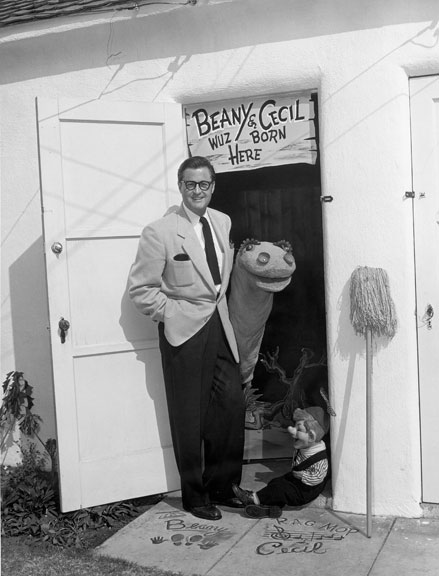
Bob Clampett in front of the garage where he created Beany and Cecil.
TWD: Where were you living at the time?
Ruth: My mom and dad had bought a house in the Hollywood Hills, actually right under the Hollywood sign. They were living there when he passed away and I lived there while I was at school. But I think at that time I had moved into an apartment on Sycamore, right off Beverly.
TWD: It’s probably still there.
Ruth: I love that whole area. It’s really home to me, because I grew up around there. That area has a lot of characters … interesting places and people.
TWD: So you design a lot of the cel art produced here at the studio?
Ruth: I’m really an art director for the work I produce. Some things I have a real minimal involvement in, and others I have a lot. It kind of depends on what the project is and the property. For instance, we represent the Fine Art of Harry Potter as one of our lines. When we first started, we had to convince Warner Bros. that there was really a market for it, and that this was something important to offer to the collectors. The first pieces we released were a series of pastels done by Mary GrandPre, the artist who did all the covers for the Harry Potter books. She’s a really wonderful woman. She had done some other scenic, I’ll show you as we walk around the studio. The one in my office is of Harry playing Quidditch.
So other than choosing what images to publish — they were already done — and I had no input in the original art. Later, we did some pieces that were character studies, and we went with film frames and graphics that I art directed. So it depends on the project.
Here on this wall for instance are three Loony Tunes pieces I worked on. On the far right is an image from one of dad’s classic cartoons with the Carmen Miranda/Bugs Bunny. It’s is a very iconic image. The thing I wanted to do with that piece besides make it larger and more impactful than a traditional cel, was to give it a little more depth even though in the cartoon it was painted in flat colors. So for that artwork we had an artist airbrush overlays and give shading to the piece. So there’s some thirty overlays he did to every cel in the edition.
The artwork in the middle was a piece I heavily art directed, it’s called The Origins of Tweety. And for that I took different elements we have in our family’s archives; like Dad’s nude baby picture that inspired Tweety; a cel from when he was originally a pink bird; and some of the original drawings and other elements. Also we have tapes of him talking about creating Tweety, so I transcribed one of them and printed the text on vellum. That’s an example of a piece that was heavily art directed.
The one on the far right was a tribute to Friz Freleng after he passed away. I have fond memories of working with Friz on his art, so I wanted to do something special for him. Also at the studio there had been such a precedence when Mel Blanc died and they did the “Speechless” image tribute. It’s where all the characters are standing on stage with their head bowed. Mel’s microphone is standing alone. It was originally an ad placed in Hollywood Reporter and Variety and people had found it incredibly moving.
Well, we ended up making Speechless as a print to sell at the Warner Bros. Studio Stores. It was the single best-selling item in the history of the stores. It sold well over 100,000 units. And we still sell them every week.
So this became a tradition. When someone key from the studio passed we would create tribute art. For example I had grown close to Friz when we were working on his cels with him. He would select the art and I would do some of the designs, and work with the background artist and get the colorizations done. Then I’d show the work to him. It was a sweet time and I really developed a fondness for him. So when he passed away I didn’t want to do a similar piece with all the character standing around and crying. So I worked with an artist and he came up with the idea of Yosemite riding off into the sunset, and I thought it was really moving and fitting for Friz.
TWD: Yes, I remember that. I also remember the Beany and Cecil ad in Variety when your father died, where Cecil has a tear rolling down his cheek.
Ruth: Yes, I remember well my family wanting to do something special for Dad. That was such a difficult thing to work on. How do you convey everything you want to say about losing someone so important to you in a single image?
So back to my working process with my business. Some of the art we publish I have a lot of input on and others, like DC comics, less. With DC we’re working with existing art that the artist has done for books or comics and so we’re essentially reproducing it, and at that point my job is to make sure we get the best possible quality print. One of the most important aspects of what I do concerns my relationship with the artists I work with. I think growing up with an artist, I just understand and respect them so much. As you can imagine, they don’t always get treated that way. So I make sure they’re happy with the image, and they’re happy with the print. And I always follow through with them and make sure I do what they were promised. So that’s made all this a really good experience all the way around.
TWD: I really like the work you’ve done on the pieces you’ve shown me.
Ruth: Thank you. I’ve been involved with this business for over 25 years, and I really love it. It’s been quite a journey. When I started and it was just Bob Clampett animation art in the building on Seward in Hollywood. It was just focused on dad’s work, of course. And at that point there really hadn’t been a market for unsigned art. But I believed that if the image was strong enough, that people would want to buy it. So we did really well. We had that business from 1985 to 1993. And at that point Warner Bros. had opened up their stores. And they had galleries planned for them. And they decided that they wanted to run the business themselves. So they offered me the job to be the art director for the program. That’s how I ended up at the Warner Bros. stores.
TWD: I had a friend who used to work at WoodHolly, which was right across the street from your studio in Hollywood on Seward. They have since gone out of business.
Ruth: Yes, I remember them. It’s happened to a lot of companies. I used to have twelve people working here and we did a substantially bigger business. And there was a point when the economy and art market collapsed where I thought we were going to have to close. So now we have a smaller group of employees and we’re more conservative about the risks we take as a company. But we’re still in business and that’s a good thing.
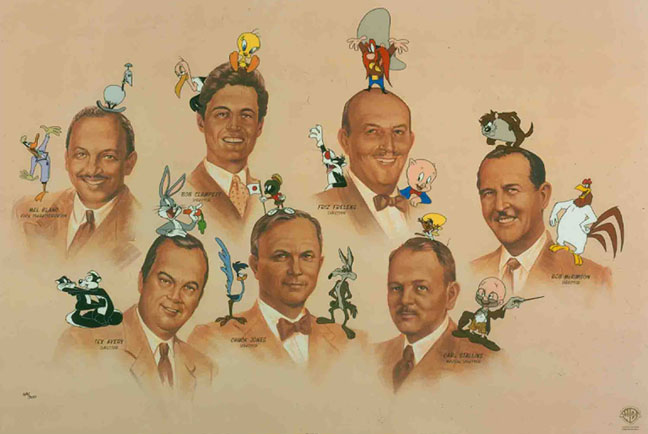
The legendary Masters of Animation at Warner Bros.
TWD: When you were growing up, were there lots of other animators around?
Ruth: In terms of animators, dad was really good about staying in touch with people he worked with. He was also friends with a lot of young animators. So there were often parties, or he would take us to events and things where we got to be around animators. There was a period when they were doing commercials, so I could go to the studio and see the process, or doing some puppet work. But it wasn’t full-on series production. We had a lot of exposure to my dad’s studio and work growing up, and my mom ran the business for my father. They were together twenty-four hours a day.
I was too young to remember much during Dad’s busiest period of animation production. But he did have his family involved in his animation world. With Beany and Cecil, Beany’s girlfriend was named Baby Ruthie, in my honor. At the time they were making that cartoon, I was not even talking yet. So dad got me to giggle on a voice track. Whereas my brother is a few years older than me, he did some of the voices, and my mom did voices as well.
TWD: Are your siblings involved in the business, too?
Ruth: I have a younger sister, Cheri. She lives in Santa Barbara and is a yoga instructor, and teaches seminars and has a published book on her specialty in restorative yoga. My brother has a video production company and does a lot of interviews and documentaries.
My brother, sister and I are dedicated to our family’s issues and we meet once a week to talk and help take care of our mom, who has Alzheimer’s and was diagnosed twelve year’s ago. We tried to keep her home as long as possible, but now she’s in an assisted-living place.
When we meet we also talk about issues and developments with Beany and Cecil and Dad’s other work. There are always projects developing. My brother produced the Beany and Cecil DVDs and promotes them and Dad’s legacy through Facebook and the social media. So he works on projects like that. He’s the archivist of the family. He’s married and has two grown sons.
Back in the day, Mom produced Beany and Cecil with my Dad. She completely understood animation. So we grew up with a pretty strong knowledge of it. I’m also friends with all the children of the other Loony Tunes directors.
I’m proud to say that I have a broad knowledge of the Looney Tunes cartoons, not just my Dad’s work. I have favorite cartoons of all the cartoon directors, and I’m very familiar with all of their careers. Part of that knowledge came from when I was head of animation for the Warner Bros. Studio Stores and we did scenes and research for all the directors. At that point, it wasn’t just focused on my Dad’s work. So that’s given me the opportunity to learn and be exposed to a broad range of animation history.
I have a piece I designed currently hanging in my studio. It was designed at the high point of the Warner Bros. Studio Stores and it was titled “The Masters of Animation.” At WB we had our flagship store in New York at 57th and Fifth Avenue. When it first opened, it was an impressive three stories, and the gallery was on the third level. When the store was being developed they asked me to design a mural for one of the key walls in the gallery area, specifically some sort of tribute to the directors. As I began working on concepts one of the challenges was that there’s no great photograph of all of the Looney Tunes creators in their prime. So I composed this image of the group, surrounded by their characters and had it rendered in a sepia tone using bits and pieces of reference I had gathered. It was such a sensation that we did a cel of it and sold it in the galleries.
TWD: I heard that your dad was a collector himself. For instance, when they threw the animation cels in the trash, he would get them and keep them for himself.
Ruth: Yes, he kept a lot of things. Part of it was that he just loved the art form so much. And he started working at Warner Bros. when he was seventeen. He was very wide-eyed and young and every part of it was magical to him. Dad grew up in a very rough time. His parent’s were separated, and didn’t have any money. At one point he and his mom even had to live separately with different relatives just to get by. So to him, getting his dream job was a really big deal. He just thought the whole thing was amazing.
In terms of what we have in our collection of Loony Tunes, a lot of it is the original drawings. Because that’s what dad was working on at the time, and what he had his hands on. He has storyboards and layout drawings. We don’t have a tremendous amount of cels. But we have some really interesting things in the collection. We have Carl Stallings baton that Carl’s wife gave dad after he died. He and Carl had been very close friends.
In our collection we also have the first statue ever done of Bugs Bunny. My dad sculpted it so he could have the animators actually view the character from different angles. I’m trying to think if there’s a photo here so you can see it. I’ll show you one in the other room.
TWD: Is that the one that was sitting on his desk?
Ruth: Yes, and there’s a funny story about it. Over the years it started to deteriorate so we decided to have it professionally restored. I’m pretty sure that my brother researched it and found the best place to have it restored, which was the Getty Museum.
It was so great because I remember my mom, brother and I taking it to the Getty to drop it off. I admired my brother for having the guts to call and ask if they’d do it. And I’ll never forget walking in there past all the Roman antiquities and there we are with this box with Bugs Bunny’s ears coming out of the top. But for them they were thrilled. It was something so different and something so contemporarily iconic that they were really very charming about it.
As for the rest of our archives, as you can imagine, with Beany and Cecil, Dad saved everything. I mean he saved the cels, some of them at different points were donated to museums and things like that, but for the most part he saved a lot of stuff and the sad thing is it’s really daunting for us.
TWD: Is it similar to the scene in Raiders of the Lost Ark, where there’s a large warehouse filled to capacity?
Ruth: That’s what it’s felt like at times. And the thing is when we had the building on Steward St., a huge space in the basement of the building which ran almost the entire length, was crammed full of stuff, and the problem is dad kept everything. So as you try to sort through it, it is a blinding mix of really important things, and some less so, and some things aren’t important at all. He was the kind of guy that if a comic book was printed, understandably he’d get a box of 100 and he’d save those, so it easily got out of hand.
While trying to sort through the archives there were a lot of different things we had to deal with, because we had to sell the building to pay for my mom’s care. And at the point we did that … I think that he would have loved to have had everything formal and beautifully archived, but you can only do what you can.
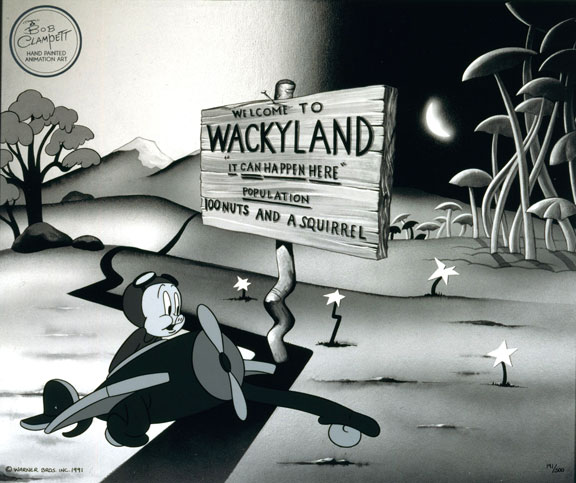
Welcome to Wackyland with Porky Pig.
TWD: Like a museum, actually?
Ruth: Yes, and I wish the art was somewhere people could see and enjoy it. That’s something my brother and sister and I feel a real responsibility to do and yet it’s daunting.
When I think about what to do with the collection I get really sad. Or maybe sadness is the wrong word, I don’t know what word I’d use, but you know we are very overwhelmed and have big ideas but no time or money to act on them. We’re all working very hard to earn a living and support our families, and the way it worked out it’s not like we’re sitting on a lot of money to manage the stuff. And even if you donate to museums now, they want you to donate money along with it to care for the art. We’ve looked into all of this. I guess it’s come about because so many people have left, for tax reasons, their collections to museums, and the museums don’t have the funding to do all the archive work and maintain it.
TWD: Does your dad have stuff in the Smithsonian?
Ruth: I think there are some things at the Smithsonian and we’ve also done shows at the Smithsonian where we’ve loaned them things. We’ve done the same at the Museum of Modern Art in New York. It’s always wonderful to see the art in such impressive and respected museums, and so hopefully one day we’d like the collection to be where people could see it.
We’ve been a resource for a lot of books and material where people want Looney Tunes art and whenever we can we try to supply what they need. As a matter of fact, since I’ve had my business and because of the nature of what I do, you’d be amazed how almost every Warner Bros. book about animation they send over to me. I guess Warner Bros. doesn’t have a lot of great quality freeze frames, I mean now with the remastering and the digital process it’s less of an issue but a few years ago they would come to us because we had recreated so many classic freeze frames in the highest quality. There are a number of books that came out recently where a good portion of the images they got from our business, but I’m happy to do anything to continue the knowledge. I want to keep the legacy these men created with their work alive. I was so upset when I heard recently that something like 40% of Americans don’t know who Bugs Bunny is. That’s devastating to me.
TWD: I asked a friend of mine recently who grew up in Chicago — she’s a little bit younger — if she ever heard of Beany and Cecil, and she said no. I know the puppet show was done out here, but the animated show was nationwide, in fact it was worldwide, wasn’t it?
Ruth: Yes. But it depends on the age, in some cities the show wasn’t everywhere. Certainly with Beany and Cecil it’s more challenging now, as we all get older, to find people who really remember it. But what’s sweet to us is the ones who do have such a fond memory of it. That kind of love and loyalty is striking to me having raised a child in this last decade where there’s all these different networks with cartoons playing all the time and a million properties being thrown at them. Over the years I’ve watched my daughter fall in and out of love with different cartoons or different characters but you wonder if they’re going to hold in their heart that same passion that we do for particular shows like Beany and Cecil because they’re just inundated with so much stuff.
TWD: Sometimes it’s too much. But maybe with Harry Potter or something…
Ruth: Yes, I think Harry Potter really stands out as memorable. But to get back to what you were talking about, yes, the collection is a big issue and we also want to do a book about dad.
TWD: I was going to bring up the fact that there is no book on Bob Clampett.
Ruth: I know that a number of people at different times came to talk to mom about it, and it was something she very much wanted to see happen. My brother was telling me recently that there was somebody she did an extensive amount of work with and they pitched it, now this was probably 15 years ago, but they didn’t get it picked up so they weren’t able to get it published.
TWD: I find that hard to believe.
Ruth: I know, I know.
TWD: You mean someone wrote an entire book?
Ruth: No, but I think they had a few chapters and they had put a proposal together. It’s been a real underlying thing in our family for years. And it’s interesting because I helped Bob McKimson, Jr. last year. He’s finishing up a book about his dad. I think it will be out soon, I think he’s going to be at ComicCon in San Diego. Do you go to ComicCon?
TWD: I went once.
Ruth: Once was enough?
TWD: It was overwhelming — the long lines, all the people.
Ruth: I’m there every year.
TWD: You are?
Ruth: I don’t have a booth, thank God, that would probably kill me, I’d be so overwhelmed. It’s a retail event so because I’m a wholesaler and I only sell to galleries I don’t do the show. If I went there with a booth and retailed that would irritate them. But I go instead to support them and because I have the DC Comic’s license, that’s a big show for us and also I’m a fan. Once I’m there I enjoy being there despite the fact that the crowds are really difficult to deal with. But there’s always something I’m into, like Harry Potter or various graphic novels and collectibles, so I’ll have good time. I’ll even go to some of the panels.
Also Comic Con presents the Eisner Awards every year, which is like the Academy Awards for comics. After dad died they honored his memory by putting the Humanitarian Award in his name. He used to be a special guest every year at Comic Con and he was so supportive of the young artists and really friendly with everybody. He always tried to help people so it’s just an amazing honor. Every year I go and I present the award and give a little speech. So that gets me down there and then while I’m there I just make the most of it.
TWD: He went to a lots of shows and comic conventions.
Ruth: If he was invited, he loved to go. He was a people person and he really loved it. You have to remember that this was the time of no internet. He really passed away right when VHS was becoming popular. He was such a movie fanatic. I joke with my brother and sister all the time. If he had lived long enough for DVDs, the house would have been wall-to-wall DVDs. Because he loved old movies and early comedies like the Marx brothers and Harold Lloyd, he loved all that stuff. He would have owned every collection. So anyway … what were we talking about? We were talking about Comic Con, how did we get into that?
TWD: Um, I’m not sure…
Ruth: So I give the Humanitarian Award, I can’t remember, we were talking about Bugs Bunny and … So anyway, books. Bob McKimson Jr. might be at Comic Con selling and representing his dad’s book.
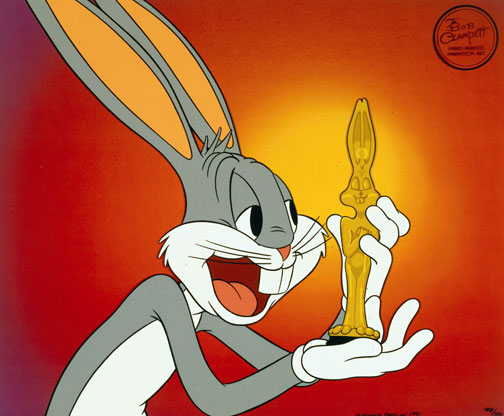
The award-winning wascally wabbit, Bugs Bunny.
TWD: So he has a publisher for the book?
Ruth: Yes, he has a publisher. It’s been very inspiring to me, making me believe I can do a book about my Dad, too. This is a different time than when my mom was first trying to get a book deal. So actually I’ve started writing a book. I’ve only just begun but I’m excited about it.
I’ve always wanted to be involved in the graphic version of whatever the story was because we have such an amazing collection to draw from and since I love design. I’m very interested in book design. I always knew I’d have a big hand in the design but I never thought that I would write the story itself.
I have done writing in the past; besides personal work, I wrote a chapter in an animation art book for Warner Bros. a while back. I’ve written forwards and material for other books. My husband is a writer. His work has been in a few anthologies.
TWD: What does he write?
Ruth: Well he got his masters in writing at USC. During that period he was focused on short stories and poetry. It’s tough to make money in any area of the arts and literature, but he never stops writing. So yes, I’ve always been exposed to the writing world. And all of a sudden I just started writing and I’ve written actually two short stories. I haven’t published them I’ve just done them online. But it developed quite a following for whatever that’s worth
TWD: Where online?
Ruth: It was through a fiction site. I’m not going to tell you because I don’t want you to read them [laughs]. But the experience taught me a lot and gave me confidence. Believe me, I respect writers so much and I don’t want to underplay the years of dedication and work it takes to develop your craft, because I know how difficult it is to do. But I really do want to give this a shot.
The thing that’s good for me about working on dad’s book is I’m hands-on and familiar with all the material. For instance, in 1978 dad was diagnosed with melanoma cancer and even though his prognosis was good it was a scare. Because he was historically minded he went into a room for a few days with a tape recorder and essentially told the whole story of his life on tape. We stored away and treasured those tapes. So after he passed away my mom had them transcribed.
I’ve started rereading those notes and it’s so interesting. It’s sad in a lot of ways, but he was so internally optimistic. His childhood was really interesting. So it’s exciting for me to delve into all of that and start putting it together. It’s going to take a while though.
TWD: You could do an ebook as well.
Ruth: Yes, the internet has changed everything hasn’t it? It overwhelms me. My sister is married to a computer programmer, he got his masters in UC Santa Barbara. He just recently came up with his own App and he got some backers and he’s trying to make that happen. But the whole internet world is very overwhelming. I’m sure the changes have shaken up the publishing world, but it’s also exciting how it’s opened up so many possibilities. I was telling my brother and sister the last time we met, I was very resistant initially to read things online or digitally. I like the tangible book but I finally bought a Nook when I was going to have a long airplane flight and loaded up a bunch of stories on it. So more and more I’m buying digital books, and I get emails from Barnes & Noble with new releases. A recent email showed how some digital books can have visual/film elements which would be perfect for dad’s where you can have some of his cartoons attached. We could also have clips of his interviews.
TWD: Yes, you can have audio and video be part of the book experience.
Ruth: That’s amazing! So I’m just techno enough to really appreciate what the possibilities are. Where I might not get everything, I might be a little slow to get on Twitter and do these things, but eventually I do and I see the power of them. I know when this book gets done, between Facebook and all the different websites that can expose new projects — we can get support. For example we’re good friends with Jerry Beck. Do you read Cartoon Brew?
TWD: He does a lot of shows at CineFamily, the silent movie theater on Fairfax.
Ruth: He’s got his finger on everything. And he’s got this massive amount of followers because he’s been a leader in animation for years and years. He likes to promote things that support the industry and the artists and I’m hopeful he would support dad’s book. And when you’re dealing with something where you have people very specifically interested in the story, like you might be into Beany and Cecil, because that was a very exciting time in dad’s life.
It’d be really great to be able to really reach specifically to Bob Clampett fans whether followers of his Looney Tunes work, Beany and Cecil or both. Even though Looney Tunes hasn’t gotten as much exposure by the studio over the last decade as I would’ve liked, it still could be an amazing time to put out a book. Friz has a book, I have it on my shelf. But they did it during the Studio Stores days and it has cells in it so it was very expensive. It was a high-end fine art book so not as many people got to read it. And then Chuck did his books. But this will be a different kind of book. I’m excited for the possibilities of what that can be. Like I said, I’ve got this tremendous resource of information.
TWD: Even if you self-published it, you’d sell a lot of copies.
Ruth: That’s the thing, I know we could at least break even and it would be worth it. I don’t expect to make money for my time, this is just a passion that I will feel so good about when it’s done. I adore my parents and I respect my dad so much, so to be able to do this for him would mean everything to me. I know how much it would’ve meant to him. He owned a lot of art books of the people that he loved and he cared so much that I think it would be extraordinary.
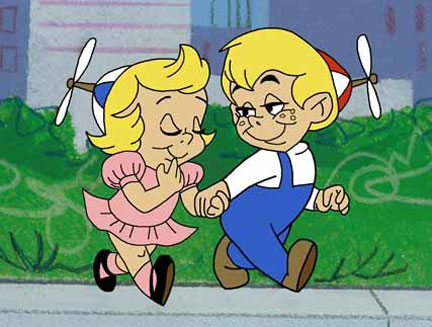
Baby Ruthy was named after Bob Clampett's daughter.
TWD: That’s what comes through in his work — his passion and enthusiasm.
Ruth: Oh, it’s huge. It’s hard sometimes. The one downside, obviously, of the whole online world is when you read Wikipedia and then there’s people online who want to create controversy or get nasty about issues between the directors, and it’s very upsetting. I’m not even quite even sure why people would want to focus on that stuff. But truly, dad was just passionate and excited about everything he did. And like you said, you could see it in the work, and we felt it growing up. We always knew how much he loved it. And I think that we all grew up wanting to feel that same kind of passion for whatever work we did. My sister is so gifted in what she does, and she travels around and works with hospitals and teaches people restorative yoga and works at cancer centers and helps people. So I think that’s the way they raised us.
TWD: So you all get together every week?
Ruth: We do, as long as everybody is in town. And again, now that we’re all on board about getting this book done, it’s going to make the meetings that much more fun. It was funny because there’s this photo, we went in to get the transcripts and my sister saw this photo sitting out of my mom and dad. We just loved it because of the way she’s looking at him; she adored him so much. There are a million little treasures like that to find.
TWD: I like her dress.
Ruth: Yes, isn’t it very ‘60s, ‘70s or something.
TWD: I see you have an iTouch.
Ruth: Yes, I love that thing. I love music mixes and I used to make my own cassette tapes, so I could have this song and that song, and it was so tedious! Putting on the albums and making these tapes one song at a time … and now the idea that you can do your playlists so easily! My daughter takes it all for granted and I’m like, you have no idea! It only takes a minute now to download a song online, create a special playlist and move the songs around or take one of them out! But I love that little thing because if I’m out and I’m at a Starbucks you can get their internet and I can check my emails and it’s not even a phone.
TWD: So were there any rebellion years for you?
Ruth: From me? No. The only thing about me was I was an ambitious little thing, and I think I told you I started working when I was 13 and bought my own car when I was 16, and went off to college and I always worked. And my mom said from the moment I could talk, she said “As soon as you made up your mind about something that was it. Just stay out of the way.” But they enjoyed that. I’d say my brother and sister were both rebellious. But that’s their story to tell. So I tried to stand out by not getting into trouble. But we were a tight family. We lived in a neighborhood with a lot of kids and there was so much going on.
TWD: You’re the middle child?
Ruth: Yes I am the middle kid, classic middle kid. It was a lot of fun. I think we watched one too many Partridge Family episodes or something. We put on a professional puppet show, and although dad wasn’t in it, he directed it. We would actually perform for money for bank Christmas parties and family events and things like that. We had this whole choreographed show because we had all the “Time for Beany” puppets that dad kept all those years, and there’s so many amazing puppets. So anyway, there was always something like that to have fun with. We also took some crazy road trips. Yeah, it was a really happy time.
TWD: Your parents were together, so that helps. I went to high school in the Valley. Then I attended CalArts.
Ruth: I considered going to CalArts and getting my masters in fine art photography. I was very interested in fine art photography because after my commercial experience I realized this wasn’t why I got into photography. I wanted to do my own thing. But the financial reality of getting my masters in photography at CalArts didn’t really work out. But I would have loved to have done that, that would have been great. It’s such a creative environment there.
TWD: Yes, it’s a great school.
Ruth: Well nowadays, we’re kind of going through this with my daughter because of high school. So we applied to some other magnets but the private schools now are $33,000 dollars a year. Everybody is trying to figure out what they can do to get by.
TWD: Somebody told me that when you go to high school now, you can basically get your AA by the time you finish.
Ruth: Well my daughter, she’s in the highly gifted program at a public school right now, but she has a friend who’s just about a genius. I was talking to her mom and she’s said, “Yes, we’re looking at this program where she would have her full bachelors degree by the time she graduates from high school. It’s run through UCLA.” I’m thinking, I’m not sure what the rush is really. But this kid is soaring through AP physics and finishing AP calculus this year so perhaps she’d like the challenge. But yes, that’s one thing very different from when you and I grew up. They even have fine arts high schools in L.A. now. The one my daughter is looking at, she’s a writer, is a humanities magnet where they do a lot of writing in the program. She’s an amazing writer. And she’s done 4 years of these three-week writing workshops over the summer. It’s was run through Johns Hopkins’ Center for talented youth, it’s amazing. She was nine her first year and learning about plot development and story arcs! She’s working on a multi-chapter book right now.
TWD: What does she write?
Ruth: Well the genre she’s interested in right now, which I guess is reflective of her age, is more fantasy based and she likes dystopian themes. So it’s a lot of animal-related characters — definitely no love stories. But she’s going through an interesting stage. Like right now she’s reading 1984 and Animal Farm, and she’s suddenly become very political. So it’ll be interesting to see how that all pans out. She just did an 80-page report on the religious right.
TWD: She’s how old?
Ruth: I know, it’s crazy! But this is what school’s like now for kids. If you’re a talented kid you get put in these intense programs. In my opinion they push them too hard, they move them too fast. But what do you do? I don’t know, I’m still trying to figure it out. I’m sorry, I went off on a tangent. All right, so what were we talking about before?
TWD: Your growing up. What sort of music were you into?
Ruth: Oh, I was pretty typical of the time. I was really into Elton john, The Who and Queen. I remember seeing concerts of all these groups: Queen, The Who, Elton John, let me think who else … David Bowie. That’s like my high school period. I remember when new wave came in. I wasn’t that much into punk. I had a great experience in high school. I don’t know if you remember this, but Elton John did an anniversary concert at the Troubadour. The Troubadour was the first place he played in Los Angeles when he first broke into America. So this was not long after “Goodbye Yellow Brick Road,” at the height of his popularity. They decided to do an anniversary concert at the troubadour on Santa Monica Blvd. and they did it as a fundraiser for the Jules Stein Eye Institute. So you had to mail in postcards and have your postcard picked to have the opportunity to buy the ticket, because it’s a small club and can only hold a few hundred people, so they got like hundreds of thousands of postcards and mine was one of the ones that got picked. I must have been 16 or something. It was done with random seating where you go and seat yourself. So we actually camped out overnight to get the best seats. I ended up sitting just a few feet from him. That was really fun. I’ve seen him a few times since. I saw him when he did Dodger Stadium. That’s the great thing about living in L.A., you can go to so many concerts, so I saw The Who at Anaheim stadium and Queen, and I saw David Bowie. I loved going to concerts. I was really into Tommy. Remember that movie Tommy?
TWD: Yes.
Ruth: It was really fun growing up in West Hollywood. We knew what clubs we could get into. Sunset Blvd. Everything was so exciting at that time.
TWD: Like the Whisky and the Roxy.
Ruth: Do you remember The Tubes? I saw them at the Whisky. Yeah, and the Rainbow. It was really a fun time. Things were not as … I don’t know everything’s got sort of an edge now. You worry about your kid and the trouble they’re going to get into.
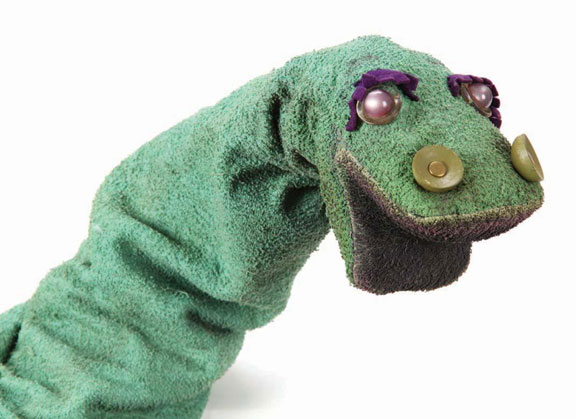
Origial Cecil puppet from Time for Beany.
TWD: Yes, it was fun. There was a whole scene back then.
Ruth: Yes, that’s true. I loved the movies at that time, Annie Hall, and Woody Allen’s whole take on L.A. So yes, I have good memories growing up in a cartoon house full of Beany and Cecil toys. Mom and dad would bring the cels home with cel paint and then we’d add characters and paint them on the production cels. Dad always meshed his work into his home life. I don’t know if you saw on the latest DVD, my brother and sister and I did a commentary on three of the Beany and Cecil cartoons. We did that at the end of last year and it was a lot of fun. We talked from a personal point of view what was in those cartoons.
One episode in particular, dad had the artist come to the house and draw the house and it’s all in the cartoon. The furniture in the living room is exact. That’s kind of how his world was all merged together. I think some artists that we knew kept their life, their cartoon life very separate from their home life. Not dad. Our whole life was like one cartoon. He was a real character so when we’d go out with him, funny things were happening. He had a great sense of humor.
We also grew up on a street with a ton of kids and there were always kids coming through the house. I have memories coming home from school and if he wasn’t working he’d be watching cartoons. So we’d sit with him and eat graham crackers and watch cartoons. He was really cool that way. My mom used to joke that she had four kids, and in a lot of ways I think that was true. He kept interested in anything that kept him mentally young. He had a great enthusiasm and child-like innocence his whole life.
TWD: What’s the picture I remember seeing of the backyard swimming pool with Beany and Cecil?
Ruth: That was on a TV guide cover. I believe to prepare for that he had an artist come and paint the characters all around the outside tiles of the pool. When they originally put the pool in he did clever things. For instance he did a Graumann’s Chinese Theatre touch where he, my mom, my brother and I all pressed our hands and footprints into the wet cement with our names written in. Those were there for years. And over by the other side with the cement he did the same thing but with some of the cartoon characters. So their footprints were there with their names. He just had a fun sense of things.
There was a point in the ‘60s where our house had bright lime green doors with turquoise trim, almost psychedelic colors. I remember my mom took him to Fred Segal’s to go shopping and he came home with white bellbottom jeans, a white denim jacket that laced up the front, with a hot pink shirt with a paisley tie. It was cool, he looked really good and he was like yeah, let’s do it. He was quite a character, really a lot of fun.
TWD: When I saw that picture, I thought, that’s the life I wanted as a kid.
Ruth: Well, it’s typical that when you’re a kid you don’t fully realize that your family is different than everyone else’s. I gradually realized it. For instance he had a thing he would do whenever we would go to a birthday party. He had a really cute colored print of all the characters, it was a publicity thing or something of all the Beany and Cecil characters and the Leakin’ Lena. The sky was bright blue with these big clouds and in the clouds he’d write “Happy Birthday” to the person, love Beany and Cecil. And so many friends later said, “I still have that framed in my room.” It was moment like that I realized, oh he’s not quite like all the other dads. By the time I got to high school the film teacher asked him to come speak at the school. I was like wow, really? But yes, for a long time I didn’t realize how unusual that was. I was lucky. I know that now.
TWD: So the puppet show was produced before any of you were born?
Ruth: Yes, that was definitely before. As a matter of fact, I think my mom met him in the middle of that after he’d already started it. She was 18 years younger than him, he didn’t settle down until his forties.
TWD: What’s your mother’s background?
Ruth: Oh, it’s quite a story … she was born in Buffalo, Wyoming. Her parents owned a café there, with a counter and two booths. She was a waitress for them when she wasn’t in school. That was her life there. Then her dad died, I think when she was 20 and her mom, who is a chef and a cook, just didn’t see how she could run the restaurant without him. So they decided to move to Los Angeles to live with my mom’s aunt. Grandma tried to get a job as a cook. They were of a very modest income.
TWD: Sounds like Mildred Pierce.
Ruth: Oh, yes. So mom ends up in L.A., if her dad hadn’t passed away it would have never happened. I believe she went to secretarial school. And they didn’t tell us the story of how they met for a while because they thought it sounded weird. The story is that my mom had a friend that she met when she moved here that was getting married. The night before the wedding they went to a bar on Sunset Blvd. to celebrate and have drinks. It was before the whole bachelorette parties scene or whatever. Anyway, the girl was starting to have second thoughts. So mom took her out of the party to talk outside. My mom’s talking to her but walking backwards down Sunset Blvd as they talk. Well my dad was so intrigued like, “Why is this woman walking backwards?” So he pulls over and they start talking and that’s literally how they met.
I can only imagine for her, this young girl from Buffalo, Wyoming, and at this point he’s got “Time for Beany” on television. She was swept off her feet and he’d take her to the Copacabana, to these clubs in L.A. And she got to meet William Holden and other stars, at that point dad was pretty well known. She was certainly in another world, and he was a good-looking guy and very, very sweet with her. He adored her. They had such an unusually wonderful relationship … they set the bar impossibly high. I mean to this day I think I’m kind of ruined for it. They had such an unusual marriage. I had never seen another one quite like theirs. I think because he was older she really babied him. She just wanted to take care of him and she admired what he did so much.
She also had an enormous inner strength. She was like a cowgirl; don’t mess with her husband. If there was somebody not being nice, or if there was a problem … He called her Super Sody, she would just not tolerate it; she would not put up with it. She looked out for him all the time. They made a really good team that way. He had a really sensitive soul. One thing I’m glad about is he didn’t live to see the internet. I think it would have killed him to see some of the stuff people say. Because he was very sensitive and he was a very kind person. Some things are just … wrong.
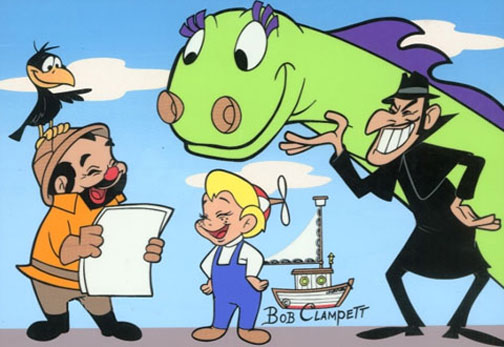
The Beany and Cecil Show featuring Beany, Cecil, Uncle Captain and Dishonest John.
TWD: I can’t imagine. You don’t have to tell me, but what's there to say that's bad about your father?
Ruth: There’s sort of a long history of the media reporting things incorrectly and then everyone getting upset about it. I understand how it happens, having worked in this business for a lot of years. Even when I was interviewed as an executive at Warner Bros. when reporters put the story together, depending on whatever their particular need or focus was, stuff gets simplified, big statements get made. So if Chuck Jones did an interview or Friz Freleng did an interview or dad did an interview, the interview would come out, “Meet the father of Bugs Bunny and all the Looney Tunes characters.” So then everybody else gets ruffled, “So now you’re claiming you created everybody,” and they don’t stop and think, well maybe he didn’t say it that way, that’s just how it came out in print.
Well, he’s one of the fathers of Bugs Bunny. But he didn’t create him solely. And that’s the sort of stuff that would set people off. We have in our files a telegram dad sent after he’d done an interview with some magazine. They never showed it to him and then they released the issue the story gave dad credit for everything. He immediately sent a telegram stating, “You need to recount this article, this is inaccurate, this isn’t what I said. It took an entire teams to create the cartoons.” But it’s too late isn’t it? The damage has been done. But because he lived less time than Chuck and Friz, he wasn’t around to defend himself. I have often read, “He wants to take credit for too much.” And who will ever be able to say exactly who did what. I think in the end they were all brilliant. They all did amazing work. Is it that important to dissect every detail and idea that lead to a great character or cartoon?
TWD: Yes, I mean his own body of work stands on its own. He did his own puppet show, he did his own animated TV show.
Ruth: Yes, there’s no reason to nitpick over who had the most influence on Porky Pig. But some people want to go there. So that’s what happens on the internet. But as I said, there’s great information shared as well.
TWD: Did you, as a family, take trips together? Did you go out of state or out of country?
Ruth: My parents were always struggling a bit for money so we never had any elaborate trips. Dad was much better creatively than business wise. He definitely had some deals not go well for him. But we were raised with a lot of love and very involved parents, so the money thing just never felt like a big deal to me.
We would do smaller trips for the most part, never overseas. Although one year we took a crazy road trip where we drove all the way to South Dakota. My mom had her high school reunion in Wyoming so the intent was to go to that, but along the way stop at all these key places. That’s a very vivid memory for me. And we would do things like a cabin in Yosemite.
My parents really loved the beach. They had a particular fondness for Hermosa Beach. They actually lived there for a while when they first got married. So whenever we could, we would rent an apartment for a week or a month and that was always a very special time for us. Later in life, things got a little better for them, like when Beany and Cecil came out on video and they got the rights back to the cartoons.
TWD: Oh, they lost the rights?
Ruth: It’s not that they lost them, I think that part of the original deal, they didn’t have full ownership of them for a certain number of years. So when they did get it back and were able to do videos TV deals, things got a little better. At that point they started traveling more, they went to Europe which was a dream of theirs. But at that point us kids were in college and doing our own thing.
The other cool thing that my mom did, around the time when I was in high school was get dad on the college circuit. She thought about how he was part of early history of animation starting with his involvement designing the first Mickey Mouse doll for Walt Disney when he was fifteen. He had all of these incredible experiences over the years. So they put together a lecture tour on dad’s career and the history of animation. My mom was his agent and they sold it to the colleges and for about two or three years they traveled all over the country, visiting all these places and speaking. He loved that. He got to meet people like you who were big Beany and Cecil fans or big Looney Tunes fans. It was incredibly gratifying for him. So that was an exciting time for them. That was how travel played out in my family.
TWD: I don’t travel as much as I used to.
Ruth: Traveling’s expensive but it’s my passion, so I’d give up almost anything so that I could travel. My mom realized after dad died, that she didn’t want to wait to take the trips she’d dreamed of. They always did the best they could for all of us but there wasn’t much money for travel. So the year after dad died mom took my sister and I on a trip to Europe. We didn’t go the expensive way, but still, we went to Europe. And then she took my brother and his wife to Japan where his wife is from. So I kind of grew up, and what she learned from the whole thing was, you only live once, do these things now. So I’ve kind of raised my daughter that way. I’ve traveled with her a lot. That’s like my thing, that’s the one thing I want to do. It’s a gift when you can do it. I’ve been to Barcelona, it’s a great city with great museums. I enjoyed the Dali museum. There’s a really nice Picasso museum, too. It has a lot of paintings he did in his teens that are more representational and they’re remarkable. And I’m a big fan of Miro and they have a beautiful Miro museum up on the hill there. It’s a really beautiful city. If you are a fan of avante garde architect Gaudi it’s a must-see.
TWD: What do you think of animation today? Is there anything that stands out or is interesting to you?
Ruth: I’ve never been one of those people who says, “Oh, animation was only good in the old days and it’s gone so downhill,” because I’ve seen some remarkable things. Again, having raised a daughter who is really interested in animation, we’ve seen a lot. She’s actually taught herself animation on the computer. She’s getting really interested in that.
TWD: And she’s aware of the whole history with your dad and everything?
Ruth: A little bit, and I think she’s very interested in this whole idea of a book about grandpa. I’ve been reading her stuff and exposing her to it and I think she’ll know more and more as time goes on.
We’ve seen a lot of great animation through her childhood. She loved Cartoon Network’s shows and Spongebob on Nickolodeon. We’ve loved so many of the features Pixar has done. The Incredibles was great, I love Brad Bird as The Iron Giant is one of my all time favorite films. We saw Despicable Me last year. I thought it was a really good film. Also films like Tangled, I thought was really well done. And many of the Disney films like Tarzan we loved, she was fanatical about The Lion King, I’ve probably seen that a hundred times.
I have a really wide taste in animation and I appreciate a lot of different things. I have friends who are animators. So to me I always keep an open mind and know that there’s always something great being worked on and coming out. And yes, there’s plenty of muck in between all that and really tedious, formulaic stuff, but I do think there’s some very inspired things, too.
TWD: What about Miyazaki? Have you seen his films?
Ruth: I have. I definitely appreciate the work. I’m not such a big fan, just because of my particular taste. I tend to like humor or charm, that’s just my taste. But I definitely appreciate the artistry of it, and the whole atmosphere of the pieces. Alex was just talking about one of his pieces last week, as a matter of fact. My mom took my sister and I to animation festivals. So I’d get to see a lot of the European independents. There’s always some really fascinating stuff. It’s what dad always said, in animation you can do anything that comes to your imagination, that’s what is so amazing about it. That’s what I really appreciate; when artists step outside the box. On the other hand, there’s been some real minimal animation that is more story, comedy dependant work such as Beavis and Butthead and South Park that I’ve laughed at. There’s such a wide variety of what can be done.
TWD: Have you seen “The Triplets of Belleville”?
Ruth: You know what, I feel really bad to admit this, but I haven’t. Did you love it?
TWD: Yes, it’s kind of charming and subtle. But the animation is great.
Ruth: I always feel like I’ve never seen enough. For me with all the property lines that I represent, I feel like I should be reading every DC comic book and seeing every new episode of shows, and I just can’t. I just can’t keep up with it.
TWD: There’s too much to see.
Ruth: I wish there were four of me, one of them could just be devoted to staying on top of this stuff.
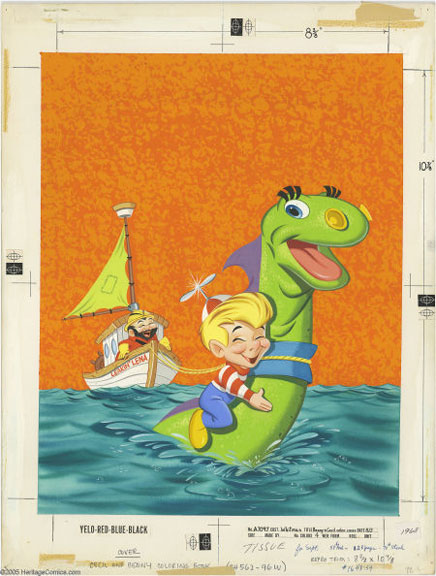
Original artwork for Beany and Cecil coloring book.
TWD: Do you collect anything? Your father was a collector, right?
Ruth: My dad was a collector, and I feel like he covered the animation art part. Although I guess you could say that technically, I own thousands of pieces of animation in my inventory alone. I acquired the inventory from the Warner Bros. Studio Stores, including original production from all the DC animated shows, Looney Tunes, Animaniacs and Pinky and the Brain. So I definitely have favorite pieces we’ve done that I would consider part of my personal collection.
I also collect photography, so if you came to my home you’d see a lot of black and white photography. Oh, I’m a collector all right. I’m my dad’s daughter. I have so many different collections, depression glass, lady head vases, Christmas ornaments, Venetian beads. I’ve got a lot of stuff that needs to stop. But yeah, it’s in my genes.
You can look around my office and see many things I cherish. I have some of my favorites here. As I mentioned earlier, I loved Iron Giant and I enjoyed working with Brad on this art. Here’s a Cecil box I painted for dad on Father’s Day. I think I was like in sixth grade or something. This is a sculpture of Beany and Cecil that was a gift from a friend of mine. And this is a picture of my family, I think I was in my 20s then. It accompanied an article about Bob Clampett Animation Art, the first version of this business. Here’s a picture of me and Friz. This is the mural that I did for the New York store we discussed earlier, and I’ll show you a cell version in the back. This was a project I’ve worked on at Warner Bros. with Quincy Jones. We did a re-enactment of “We are the World” with cartoon characters. Well, let’s walk around.
TWD: Is it okay if I take some pictures of your office?
Ruth: Sure.
TWD: I wanted to ask you about the restaurants — The Beany Drive-Ins…
Ruth: I can ask my brother what the story is behind the Drive-ins. I think it was one of those things where somebody licensed it, they came to dad and said they wanted to do a Beany restaurant … I don’t think he was a partner in it. But that was cool. There was a lot of stuff like that during the “Time for Beany” era. Back before licensing became so formulaic. For instance there were ‘50s ceramic Beany cookie jars, and there was the Drive-In, and actually the P.O.P park, which is an amusement park with ferris wheel and small rides. They had dad work on a Beany and Cecil ride. I don’t think it was ever made but there were designs for it. So there were all kinds of interesting things like that.
TWD: I went to a swap meet recently and met a guy who was selling some Beany and Cecil toys. He said he was president of the fan club. He had all this Beany and Cecil stuff. And he had things from Walker Edmiston, too, who worked with your father.
Ruth: Yes, he had quite a collection. There was a guy who was my art director for DC comics. Turns out he was a huge Beany and Cecil fan, and he had a pristine collection. He hunted down and found at least one of every Mattel toy and everything that was done, all in perfect condition. He didn’t tell me about it for a long time, though we worked together. And then suddenly one day he comes out of the Beany and Cecil closet. I thought it was so awesome.
I wish you could have seen my dad’s office; you can only imagine. It was so much fun. The toys were everywhere, and all the character sculptures. It was very cool.
TWD: Maybe he thought you would think he was crazy for collecting all that stuff.
Ruth: Well, he was so set in his ways, I don’t think he cared who thought he was crazy. It was just who he was. I think he was always confident, as you know there has to be a boldness or confidence to be an artist and really put yourself out there and believe in what you do … especially if you’re doing something unconventional. And luckily he seemed to have that. So I learned that from dad. When I was a teenager I was so self-conscious about everything. Then I would look at him and nothing embarrassed him. His attitude was, “I’m gonna try this and not worry about it and if it works, great and if it doesn’t, well I’ll try something else.” So it was a good life lesson to learn, I think.
TWD: It certainly was.
Ruth: This is one of my daughter’s drawings. She taught herself Photoshop. I love that kids are so fearless with computers now; nothing really scares them.
TWD: It’s hard to draw animals.
Ruth: She doesn’t see an artist’s career ahead of her, but I love that she enjoys it. Her latest obsession is making music videos. She takes footage from existing films and then takes a song that she really likes, then she edits it together to make her own video. The exercise is that she’s teaching herself editing and timing. The first one she did I was really impressed with. It showed a great sense of timing and eye for putting things together in a logical and artful way.
Do you want to see the studio?
TWD: Yes.
Ruth: These in the hall area are different cels we’ve done. These were actually vintage posters that were hanging in my dad’s office, but they were large. And I thought these would make fun cells, so these are hand painted cells.
TWD: There’s a cel overlaid?
Ruth: Bugs Bunny is on the cel and the painted characters are on the cel as well. It’s an unusual interpretation of the original.
TWD: Actually, I think it’s great.
Ruth: The rest of the imagery is on the background.
This was a series I did that I called Lobby Card, where I took the lobby cards of various Looney Tunes cartoons that were made to be put in theaters in the 1940’s, and used that pattern for the background. The character is hand-painted on a cel that is suspended over the background.
This is one of my favorite cartoons of my dad’s, the Great Piggy Bank Robbery, which was a whole take off on Duck Twacy. This cartoon is in the Library of Congress as one the greatest cartoons ever made. It’s brilliant.
When dad was first promoted as a director at Warner Bros., he was assigned the black and white unit making nothing but Porky Pig cartoons. He made the most of it, and this cel is one of those cartoons, Daffy Doc. My all-time favorite cartoon is Porky in Wackyland, which is a very surreal black and white cartoon made during that period. It’s wildly imaginative.
We also do Tom and Jerry. I love the artistry of the Tom and Jerry cartoons.
TWD: Yes, a lot of those ‘50s cartoons…
Ruth: Yes they’re really cool. I also publish the Hanna-Barbera fine art line.
In this room we have black and white portraits; I love the story behind these. Two artists that I knew at Warner Bros., Alan Bodner and Harry Sabin, felt that the Looney Tunes characters were just as famous as Clark Gable, Humphrey Bogart and the other big actors of the time. So they tried to imagine if they were getting their portraits taken what they would be like in their off-screen persona. That was the inspiration for this series and it was really popular. It’s fun to play with that kind of interpretive stuff so it’s not just directly from a cartoon.
This is one of my most popular artists, Alex Ross. You saw the Wonder Woman he did in my office. He still paints traditionally in a realistic style, using real models to pose. So he’s really unique in the comic world, and really collectible.
This is some production art for Harry Potter. And then these are some panels we did for a traveling exhibit on dad’s history with the studio. I love anything that helps people understand the process and history of animation.
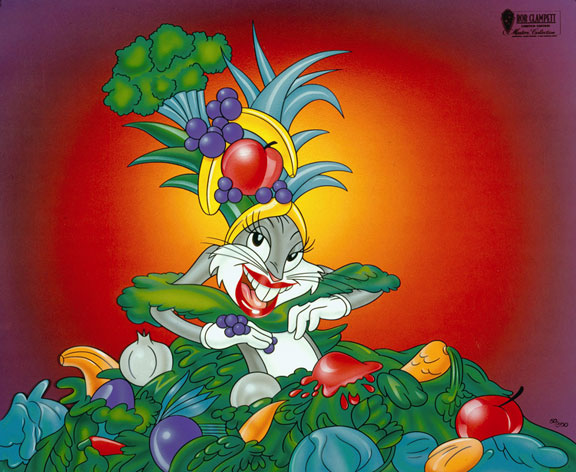
Bugs Bunny as Carmen Miranda.
TWD: On e-bay recently, I saw that somebody was selling your father’s high-school yearbook. And it had all these drawings he did.
Ruth: Really?
TWD: It was amazing.
Ruth: When dad was 12, he submitted a comic strip to the L.A. Junior Times for a contest, and he won. They gave him a contract so that when he graduated from high school, he was going to go work at the L.A. Times as a comic artist. Meanwhile they sent him to art school on Saturdays at Chouinard. Then before he graduated, cartoons came out and once he saw them he knew immediately that was where he wanted to work as opposed to newspaper comics. So his dad had to go get him out of the contract.
This was a cartoon he did that was a spoof on Snow White and the Seven Dwarves, it was called Coal Black and de Sebben Dwarves. It’s considered controversial by the people that don’t know the history of it. I can tell you it was done with a lot of love. He was the first director to use black voice artists and black musicians for the cartoon. He consulted with Duke Ellington about the project and he was excited about it.
In this piece of art, one of our artists, Kirk Mueller, did a rendition of the Termite Terrace animation studio. I love it for all the detail and emphasis on how the cartoons are made.
With this work we’ve designed a line of art for the Harry Potter Film Tour in Leavesden, England. I really enjoyed the research for this … seeing all of the development art that was done for the movies.
TWD: So this is film development art?
Ruth: Yes, like this one is of Harry, Ron and Hermione breaking out of Gringotts on the dragon. Stewart Craig is the art director for all the films, and this is one of his sketches as he was visually working out the scene. The full color rendering is done by Andrew Williamson.
TWD: I like being able to see the process behind the film.
Ruth: I’ve always liked to do pieces that show the process of animation or film. I think it’s such an interesting process.
Speaking of process, this photo is dad in one of the Beany and Cecil story sessions, acting out the scenes. And this is how his acting translated in the finished cartoon. This photo is of the garage at the house where I grew up in. It was special because he developed the Beany and Cecil puppet show at first in that garage. Later when we redid the cement he made it our very own Grauman’s with signatures and footprints in the cement.
TWD: Do you still have those?
Ruth: No, you know my mom worked it into the contract when she sold the house, that we could go get the cement slabs with the footprints, but we never did, and they’re long worn down now. We do have a lot of fun Beany and Cecil stuff though.
And then this is the Mickey Mouse doll his aunt designed for Walt. Dad did the drawings for her to work from.
TWD: Did he know Walt Disney?
Ruth: Yes. The story is that his aunt was a doll maker and said, “I need a new character.” Dad suggested this new character called Mickey Mouse. He has just seen “Steamboat Willie.” She asked him to bring her some drawings, but he couldn’t find any art anywhere of Mickey Mouse. So he went and sat through several showings and sketched him and they started making a doll.
When my grandfather saw it he told them that they couldn’t just take somebody else’s character and make a doll and sell it. So grandfather took them over to Walt’s place, a little studio on Hyperion with his brother. Walt loved the doll so he set them up in a house in Hollywood making these dolls.
Dad would see him and talk periodically, he was 16 at the time. Then when he was 17, he showed him some animation he had been working on in his portfolio and asked for a job. Walt said he would hire him but that they were in the middle of moving so he would have to wait two months. Dad was so excited and encouraged and realized he didn’t want to wait. So he went to see Leon Schlesinger who offered him a job that day. The rest is history.
Dad was very close his whole life with his high school art teacher. This is a copy of the letter he wrote her after his first week working at the studio. He sent her his first dollar he made. I love that he did that.
This is a drawing he was given his first day at WB to follow for Bosco. As a young animator, later he animated the first scenes with Daffy Duck for Tex Avery. He was an animator on Tex’s team. Then here are drawings of dad making Porky cuter for Leon after he had become rather fat and ugly.
TWD: My mom went to Marshall High school. I think Disney’s two daughters went there at the same time.
Ruth: Wow, that’s quite a legacy they got.
Here’s more Harry Potter artwork. So these renderings were done, and from there they built the sets. Are you a Harry Potter fan?
TWD: My wife is. I’ve seen the movies, but I haven’t read the books.
Ruth: Oh, the books are great. I’m a big fan.
So this is our warehouse where we do what we do. The painters work at home. My printer used to be on site, but used too much space so he’s off site now.
So piece of art I originally designed as a 20-foot mural for our flagship WB Studio Store on 57th and 5th in Manhattan. I was asked to do some type of tribute piece to the directors of the Looney Tunes cartoons. I started by finding the best image I could of each director, and then created the composition around that.
TWD: Yes, that’s a really great piece
Ruth: Thank you. It was fun to do.
TWD: Glad your dad’s on the top.
Ruth: Yes, well you could imagine the politics of where I placed everyone. I worried about how I was going to handle that and then of course where all the characters went. If you have a character like Bugs that they all worked on, I mean where do you put Bugs Bunny? It was mind bending. The most exciting thing about this for me was the Warner Bros. scenic department painted the original mural. So I got to go over there a few times and watch them work.
TWD: It was a big mural.
Ruth: Huge, twenty feet long.
TWD: So the work for your business is all done here?
Ruth: The planning and design for the art happens here. Then the final stages where we curate and put the elements together happens here as well.
We also have inventory that was acquired from Warner Bros. like this cel, “Anchors Aweigh.” When this was produced they took a frame of the Gene Kelly film, “Anchor’s Aweigh,” then printed the background from that film frame where Gene is dancing. Jerry is then on the cel layer which is intricately hand-painted. This is very special because it is signed by Bill Hanna, Joseph Barbera, and Gene Kelly. It is highly collectible.
Ruth: This huge painting was done of my dad from a picture taken when he was in his thirties. It was done by the WB Scenic department. Sometimes when I’m here late at night and I get ready to leave, I’ll say “Bye, dad!” It’s cool. I love this photo because it was him at the height of his career at Warner Bros. He was a good-looking young guy.
TWD: Yes, it’s good lighting. Are there still any Warner Bros. stores?
Ruth: No, just Disney. My whole group came with me from the WB Studio Stores. We still miss that place. It was amazing to work there. So is the studio all you thought it would be?
TWD: It’s everything and a lot more.
Ruth: Good! That’s always a good thing. Have you seen our website?
TWD: Yes, who does the website?
Ruth: We’ve had a number of people work on the site. The original website was very cool. It opened with an animated sequence where the Dodo bird swings in, lands in his seat and the curtains part, then the art comes up on stage. My next big project is getting the whole site updated and more user-friendly. Our retail site, WildsvilleGallery.com is more organized by properties and easier to use than the ClampettStudio.com one. So we’re working on that as well. We’re always very busy here.
TWD: Thank you for your time today, I really enjoyed meeting and talking with you. It was an enjoyable experience.
Ruth: I enjoyed it as well.
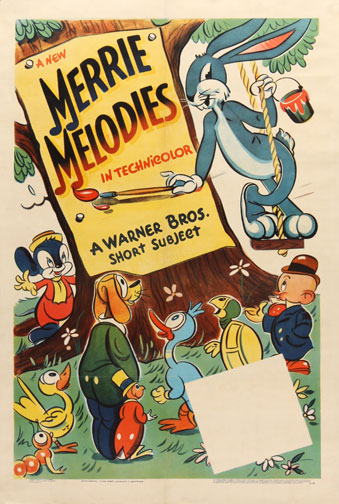
Bugs Bunny — Bob Clampett helped create this iconic charactrer.
To view Clampett Studio Collections: Animation Art
Or the retail site, WildsvilleGallery.com
ISSUE:
F A L L
2012
SUPPORT THE ARTS
GET A FREE T-SHIRT
DONATE TODAY!
By accessing this site, you accept these Terms and Conditions.
Copyright © 2010-2012 TheWritingDisorder.com ™ — All rights reserved